
Introduced in 1974 the Yamaha CR-1000 was a high end receiver that was offered in both the U.S. and Japan markets. It was part of Yamaha’s lineup that included the CR-400, CR-600 and CR-800. Pricing in the U.S. was:
- CR-400 – $330
- CR-600 – $460
- CR-800 – $580
- CR-1000 – $850
An audio magazine of the time said:
One significant aspect of the CR-1000 is its surprisingly affordable price, considering all the excellent features it offers. This makes the CR-1000 a truly unique proposition in the world of stereo equipment.
The CR-1000 is rated at 70 watts per channel. While this is somewhat low for a top end receiver of the time, Yamaha chose to focus less on power output and more on reducing distortion. This concept was incorporated in their tagline “Natural Sound”. Their marketing quote was:
By virtually eliminating IM’s (intermodulation distortion) brittle dissonance, we’ve given back to music what it’s been missing. A clear natural richness and brilliant tonality that numbers alone cannot describe. A new purity in sound reproduction.
Yamaha claimed that their heritage of producing fine musical instruments such as pianos, organs, guitars, woodwinds, and brass is what drove them to reducing distortion in their audio equipment.
The minimalist but handsome wood cabinet was included in the base price of the CR-1000.
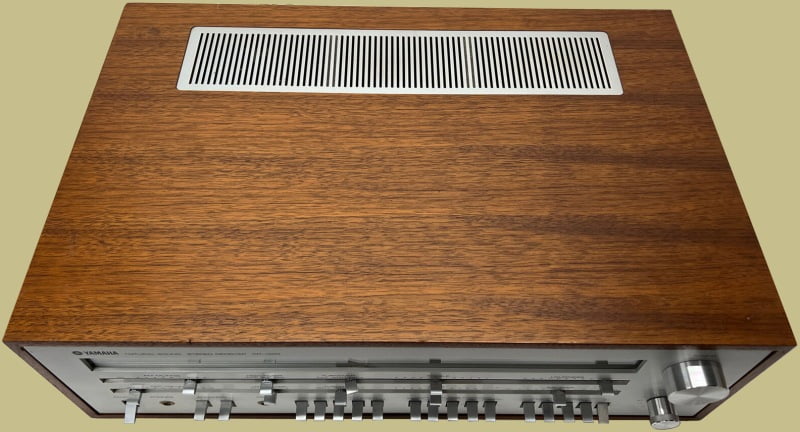
One interesting choice that Yamaha’s designers, and I assume marketers, made was to omit AM tuning. They apparently believed that most music lovers would prefer to do without it. So, the CR-1000 is FM only.
The CR-1000 controls include a rumble filter with a steep roll-off, switchable treble filter options, a rotary volume control, and a slider for microphone gain control.
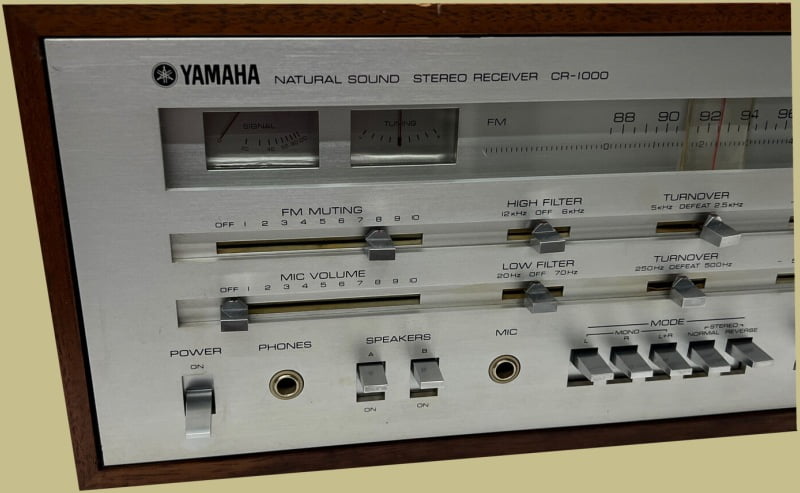
FM Tuner Section
The FM tuner in the CR-1000 has exceptional reception quality, thanks to its elaborate 5-gang tuning capacitor and a triple tuning circuit with dual-gated MOS-FETs. In fact, it achieved the highest level of FM reception possible for a tuner, regardless of cost, at time of production. The FM tuner is characterized by precise and accurate tuning, complemented by signal strength and tuning meters.
With its super-sensitive front end, selective IF amplifier, and advanced FM multiplex demodulator, the CR-1000 has an extremely well designed FM tuning section. Yamaha even introduced a groundbreaking feature in the FM demodulator – the adoption of negative feedback in its transistorized switching circuit. This was a first of its kind feature. This innovative circuit takes part of the switched left-channel and right-channel signals and feeds them back to the original composite signals, effectively reducing distortion in the multiplex demodulator to an impressive low of 0.05%.
The FM IF amplifier in the Yamaha CR-1000 is an intricate design that set new standards at the time. Its components include a discrete differential amplifier, two specialized high-gain integrated circuits containing six differential amplifiers, and three ideally phase-linear bi-resonator ceramic filters. These components contribute to the IF amplifier’s exceptional phase linearity and extraordinary band-pass characteristics.
The IF amplifier boasts an impressive 80dB selectivity, meaning that your favorite FM station remains undisturbed by neighboring stations. With a capture ratio of 1.0dB and low distortion of 0.15% at 400Hz for FM mono reception (or 0.3% at 400Hz for FM stereo reception), the IF amplifier delivers excellent clarity. Even in challenging urban areas where station jamming is common, the CR-1000 performs at a high level.
Tone Controls
The bass and treble controls, like the balance and loudness controls, are slider-type adjustments, with a choice of two switch-selectable inflection points for each as well as a DEFEAT position. The high and low-cut filters have 12 -dB-per-octave slopes and a choice of two cut-off frequencies.
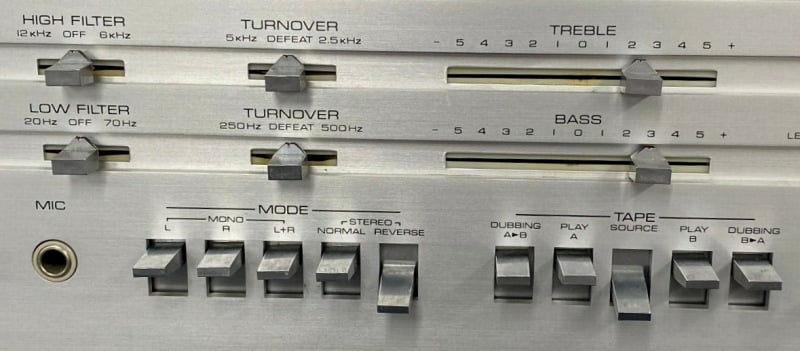
Auto-Touch Tuning
To select your desired FM station, you simply touch the Tuning knob and the built-in AFC (Automatic Frequency Control) circuit shuts itself off for accurate tuning. Once you have “tuned in” the station, this AFC circuit activates as soon as you release the knob, guaranteeing steady, drift-free reception regardless of fluctuations in the power supply voltage or changes in the temperature of the tuner circuitry.
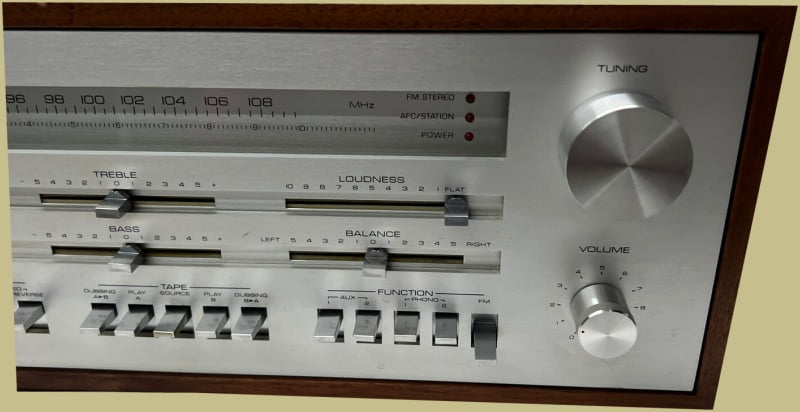
Yamaha used LED lamp indicators for power, automatic switch over from FM mono to FM stereo reception, and the automatic AFC/STATION selection. The AFC/STATION indicator glows in half-brightness when a station is tuned in; it changes to full brightness as you release the Tuning Knob, indicating that the AFC circuit is working.
The wide, frequency-linear FM dial, has a slide rule type design. Yamaha claimed to have devoted extra research to what they called “this important feature” to develop a smooth, over-sized flywheel and precise tuning mechanism.
The signal strength meter of the CR-1000 has some unique features. Unlike traditional meters found in other receivers and tuners, this meter incorporates an AGC (Automatic Gain Control) circuit that enables it to accurately indicate input signal strengths up to 100dB. Rather than easily deflecting the entire length of its scale, this meter provides more precise measurements. As a result, aligning your FM antenna for optimal reception becomes a straightforward task. Additionally, the center-of-channel meter, positioned next to the signal meter, deflects to the center of its scale when the tuner is precisely tuned to the center of the FM discriminator output. This center point represents minimal distortion and maximum stereo separation, ensuring an enhanced listening experience.
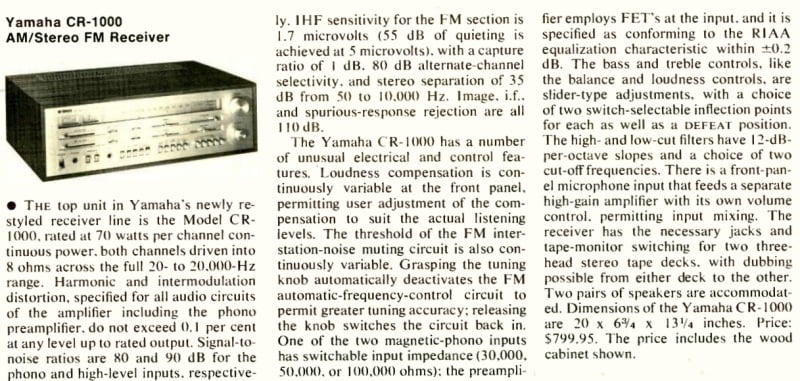
Loudness Control
The CR-1000 incorporates a loudness contour that is a bit different. It addresses the human ear’s limited ability to perceive low-level bass and treble signals accurately relative to the actual sound volume perceived. It takes into account various factors such as speaker efficiency and room acoustics to provide continuous adjustment of the loudness contour for optimal audio reproduction.
Using the loudness control is straightforward. To begin, you set the loudness control to the FLAT position. Next, adjust the volume control to your desired maximum listening level. Finally, to lower the volume below the previously set level, you turn the loudness control (not the volume control) accordingly. By following this procedure, the loudness contour ensures that your ears perceive a consistent balance of lows, midranges, and highs across all volume levels.
This intuitive operation allows you to maintain a desired tonal balance regardless of the volume, resulting in an enhanced listening experience.
Preamplifier Section
The CR-1000 features an advanced phono equalizer that incorporates cutting-edge technology for exceptional performance. This equalizer utilizes a unique SRPP (shunt-regulated push-pull) input stage, employing carefully selected junction FETs, and a SEPP (single-ended push-pull) output stage consisting of high-quality silicon transistors. With an impressive input signal capacity of up to 280 millivolts, the CR-1000 delivers a wide dynamic range, providing a phono overload capability of nearly 100 times or 40dB. Its phono input sensitivity is set at 3 millivolts, ensuring a super-wide margin against distortion.
This circuitry not only results in excellent performance but also contributes to an exceptionally high signal-to-noise ratio of 80dB, effectively minimizing pulse-like noise. Of equal importance is the phono equalizer’s ability to faithfully reproduce the RIAA disc playback characteristic, with a deviation kept within ±0.2dB. These specifications highlight the receiver’s capacity to faithfully reproduce every nuance and detail of your records.

Amplifier
Power output of the CR-1000 is impressive with a continuous RMS output of 70 watts per channel into 8 ohms, both channels driven, and a total harmonic distortion of only 0.1% across the 20-20,000Hz frequency range.
The power amplifier delivers exceptional performance. It features a direct-coupled architecture that combines a two-stage differential amplifier with an output-capacitor-less (OCL) pure complementary Darlington amplifier. While the output performance of a direct-coupled amplifier is remarkable, its stability and safety are directly influenced by the reliable operation of the differential amplifier and effective temperature compensation. In the CR-1000, the power amplifier’s differential amplifier is designed with a combination of field-effect transistors (FETs) and carefully selected silicon transistors. It benefits from a constant-current bias, ensuring outstanding stability. Additionally, a specialized transistor is incorporated to provide optimal temperature compensation.
Yamaha’s thoughtful design and implementation of the power amplifier in the CR-1000 gives it exceptional stability, accuracy, and fidelity. The direct-coupled architecture, combined with the differential amplifier’s stability and temperature compensation, as well as the OCL power amplifier’s wide bandwidth and low distortion, all contribute to the impressive performance and audio reproduction capabilities of the CR-1000.
Specifications:
- Tuning range: FM
- Power output: 70 watts per channel into 8Ω (stereo)
- Frequency response: 10Hz to 50kHz
- Total harmonic distortion: 0.1%
- Damping factor: 70
- Input sensitivity: 3mV (mic), 3mV (MM), 150mV (line)
- Signal to noise ratio: 70dB (mic), 80dB (MM), 90dB (line)
- Channel separation: 50dB (MM), 50dB (line)
- Output: 150mV (line), 0.775V (Pre out)
- Speaker load impedance: 4Ω to 16Ω
- Semiconductors: 2 x IC, 2 x MOSFET, 10 x FET, 98 x transistors, 56 x diodes, 6 x zener diodes
- Dimensions: 20″ x 6 3/4″ x 13 1/4″ (510 x 174 x 335mm)
- Weight: 42 lbs. (19kg)

The CR-1000 is provided with double protection circuits for the important power transistors and for your valuable speakers in the unlikely event that the direct-coupled power amplifier should malfunction. One is a circuit that detects the power dissipation of the power transistors and regulates the input signal the moment the power exceeds the ASO (area of safe operation). A second means of protection is a new relay-equipped speaker protection circuit patent pending that prevents direct current from reaching your speakers—and harming them. The circuit returns to normal operation automatically when the abnormal condition disappears. It also cancels the popping noise that is generated when you turn the power switch on or off.
You can find quite a few parts for the CR-1000 on eBay. To see what’s available now check HERE.
The back panel features:
- Two Phono Input Circuits, with Input Impedance Selector (100, 50 or 30 Kilo-Ohms) for Phono-1.
- Connections for two tape recorders.
- Two AUX inputs
- Four Convenient AC Outlets (Two Switched – Two Un-switched).
- Two Large Grounding Terminals.
- Pre-out Main-in connections.
- One-Touch Speaker Terminals
- IF Output for 4-channel Capability
- Multipath Output for Improved Antenna Setting
- Connections for two pairs of speaker systems (you can listen to one or both pairs simultaneously).
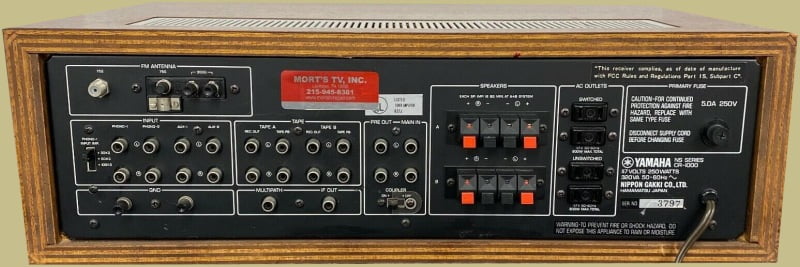
One downside of the CR-1000 was noted in an audio magazine’s performance test. They found that:
Comprehensive IM sweep tests corroborated the findings of the listening tests, revealing relatively weaker performance in bass frequencies.
So, if you’re someone who needs really good bass response then be sure to listen to a CR-1000 before buying one to make sure it meets your standards in the lower frequencies.
Yamaha’s CR-1000 definitely meets expectations with its outstanding performance and conservative yet impressive specifications. It combines a top-notch FM tuner and a high-power amplifier, delivering exceptional sound quality and reception. Overall it is a very good receiver.

